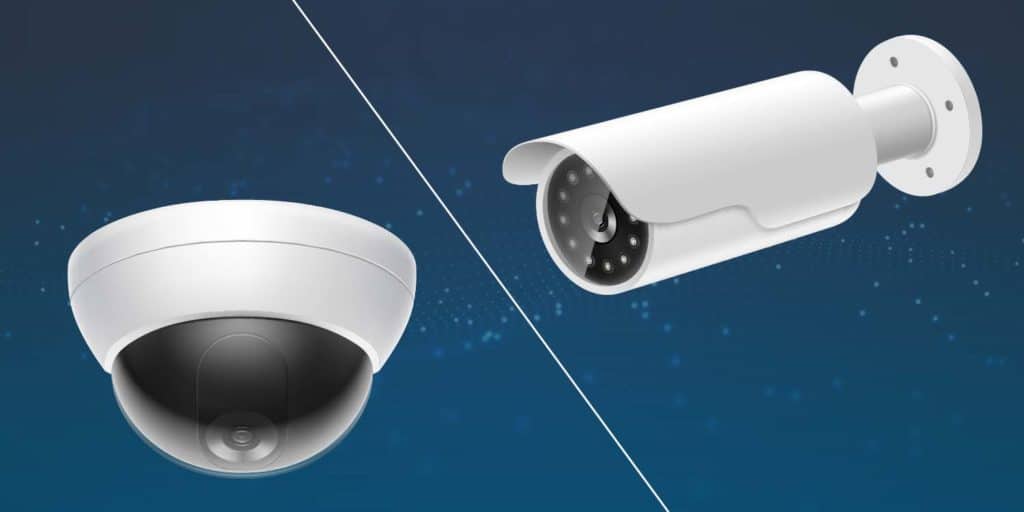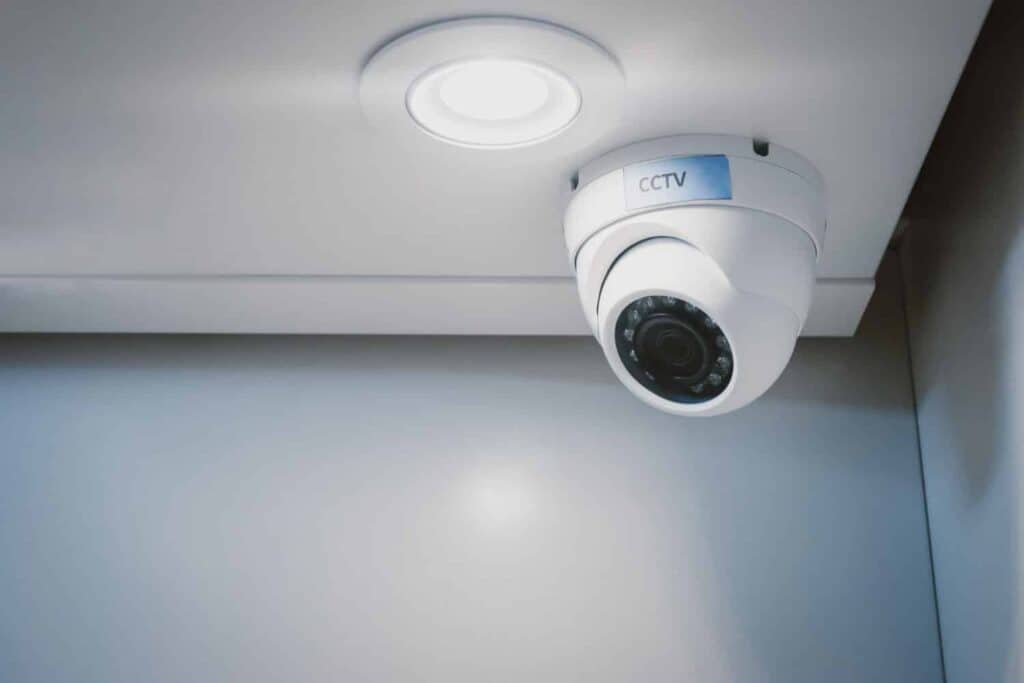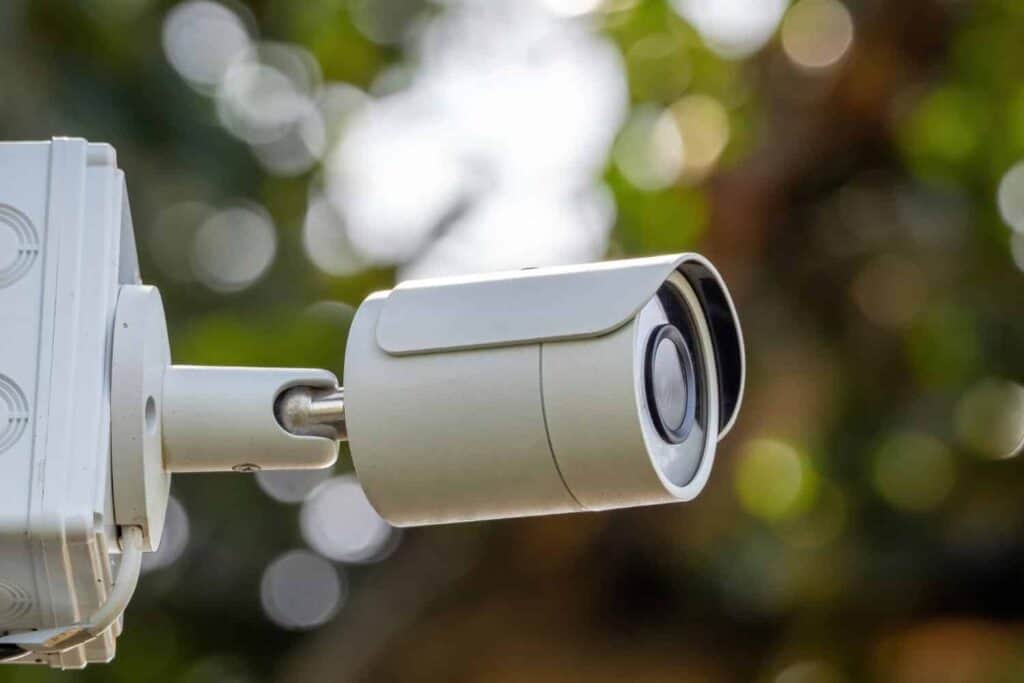If you’re considering a dome camera vs. a bullet camera for your business, what you choose depends on what you need.

Things like shape and design, as well as extra features, affect the business security camera you buy. For example, the shape of the security camera impacts the view angle significantly. This blog will compare the two primary types of video surveillance camera designs: the dome and the bullet. When comparing the dome vs. the bullet camera, which is better for your business?
Benefits of Dome Surveillance Cameras

A dome security camera is enclosed in a hemispherical housing. This housing is usually very tough and made to withstand both indoor and outdoor conditions. Many of the dome camera models on the market today include benefits like:
Discretion
These cameras have a lower profile than bullet cameras. If you look hard, you can spot these eyes in the sky, but it’s easy to pass right by them unnoticed. This stealth makes them ideal for places where people may not expect to be surveilled.
Tamper-proof Angles
They also hide which direction the lens is pointing, which makes them valuable as a deterrent. Even if a thief can reach the dome camera, they can’t change the direction of the lens.
The Perfect View
The dome design can enclose a wide-angle view camera lens. Usually, dome cameras are equipped with a variable focal field of view. Your security team can make the adjustments necessary to cover the exact field of view you need.
Installation
A dome camera can be easily put into a ceiling or on an eave. That’s not all; these cameras are quite versatile and can fit several settings. However, once it’s installed, it’s usually not mobile. If you need to change the field of view for some reason, you should consult a professional.
Durability
These cameras are often quite durable. They tools last a long time, in part, because the camera’s delicate sensors are encased in a protective shield. You can even purchase a dome camera as “vandal-proof.” This means the camera’s impact protection rating is high.
Dome surveillance cameras work well for both overt and covert surveillance. Now let’s look at the bullet camera to compare its features.
Benefits of Bullet Surveillance Cameras

Bullet cameras have a housing that is oblong, or shaped like a bullet. As a result, these cameras stand out from a static wall or corner eave. If you want people to know they’re being watched, a bullet surveillance camera is the obvious choice. Some of the bullet camera models on the market today include these features and benefits:
Portable
They can more easily be moved, so you can change the angle of the lens.
Outdoor-proof
The housing can be weatherproofed to withstand the most intense conditions.
Eagle Eye
They offer good HD long-distance vision. This can help spot people at great distances or even read a license plate, thanks to zoom camera features.
Customized Installation
These cameras can be mounted to walls or ceilings and can be wired, wireless, or use solar panels for power.
What is the Difference Between a Dome and a Bullet Camera?
The obvious difference between a dome and a bullet camera is in their design, but the differences go far beyond looks.
| Features | Dome Cameras | Bullet Cameras |
| Typically static, hardwired into a wall or ceiling, but they don’t have to be; they can be wireless. Most of the time, however, once they’re mounted, they stay in place. | ✓ | |
| Often wireless, this frees you up to place them in very remote or rural settings. | ✓ | |
| Can easily change direction. Some even allow your security team to move the camera angle remotely. | ✓ | |
| Camera housings are often more vandal resistant, depending on where they are mounted. | ✓ | |
| Should be mounted high up to make them less accessible to vandals. | ✓ | |
| Can work outdoors. | ✓ | |
| Typically have a longer field of vision. | ✓ |
The features that these cameras offer are quite similar. The differences relate more to the shape and installation of the camera. For example, both bullet and dome cameras offer features like infrared LEDs for low-light conditions. Both types of cameras can connect to the internet. This allows your video surveillance company to monitor site activity in real-time.
Dome vs. Bullet Camera: Which is Better for Your Business?
If you’re considering a dome camera vs. a bullet camera for your business, what you choose depends on what you need. Ask yourself:
What are the types of areas I’m trying to cover?
Keep in mind you can combine dome and bullet cameras. You can also individualize key features on each unit depending on where they’re placed.
What kind of visibility does each camera need?
Do I need night or thermal vision? Do I need to cover a wide angle? Should I be able to pan the camera or widen the view from my smartphone? What image resolution is best?
What are the types of environmental hazards the camera will endure, like weather or heat?
Do they need to be tamperproof?
What kind of installation will I need—and what can I support?
Could solar panels prolong my battery life?
Should I hardwire the units? Do they need to be mobile?
Who is the audience I’m surveilling?
Workers? Customers? Trespassers at night? Can the camera work as a deterrent if it’s visible? Would adding audio and visual elements to the camera scare away thieves and vandals?
Obviously, you should be asking these and other questions when considering a dome vs. a bullet camera for your business. Before trying to figure this out we have a better question to ask: Is this something you should leave to chance? Video Guard Pro not only has the right questions you should be asking but we also have the answers. There’s no need for you to struggle with deciding between a dome camera vs. a bullet camera. Contact us for a free consultation today. We’re here to help protect what matters.
